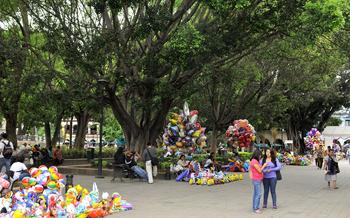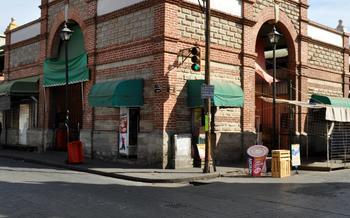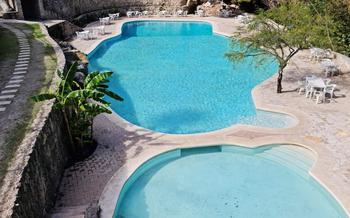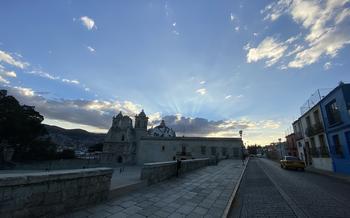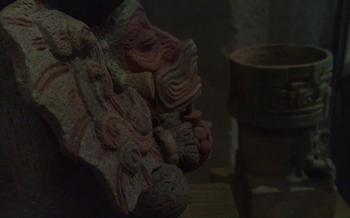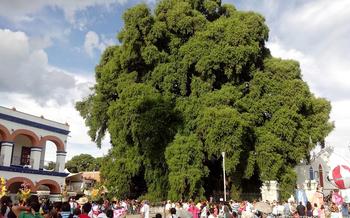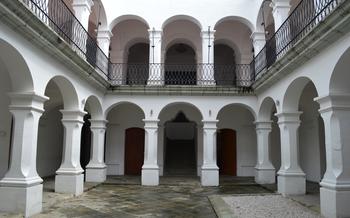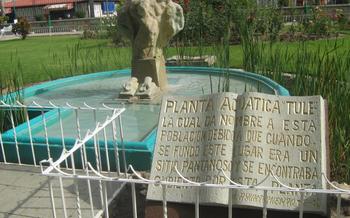
Teatro Macedonio Alcalá
- History and significance of the theater
- Stepping into the Past: The Lobby's Murals
- The Grand Auditorium: A Masterpiece of Design
- Curtain Call: The Theater's Notable Performances
- Beyond Performances: The Theater's Multifaceted Role
- Unveiling the History: The Theater's Museum
- A Stroll Through Time: The Theater's Surroundings
- Oaxaca's Cultural Heart: The Theater's Significance
- A Night Out: Attending a Performance
- Getting There: Transportation and Accessibility
- The Theater's Legacy: Inspiring Future Generations
- Local Insights: The Theater from an Oaxacan's Perspective
- Capturing the Moment: Photography and Videography
History and significance of the theater
In the heart of Oaxaca, Mexico, stands the majestic Teatro Macedonio Alcalá, a cultural icon that has witnessed over a century of artistic expressions and community gatherings. Inaugurated in 1909, the theater was named after Macedonio Alcalá, a prominent Oaxacan poet and politician who championed the arts. Originally known as the Teatro Colón, it underwent a significant renovation in 1932 and was rechristened in Alcalá's honor.
Throughout its illustrious history, the theater has been a stage for renowned national and international performers, hosting a diverse range of cultural events that have shaped Oaxaca's vibrant arts scene. It has also played a pivotal role in promoting local talent, providing a platform for emerging artists to showcase their skills.
Stepping into the Past: The Lobby's Murals
The Teatro Macedonio Alcalá's lobby is adorned with stunning murals that transport visitors back in time and provide a glimpse into Oaxaca's rich history and culture. These murals were created by renowned Oaxacan artists and depict various scenes and themes that reflect the state's unique identity.
One of the most striking murals is "History of Oaxaca," painted by Arturo García Bustos. This masterpiece portrays key moments in Oaxaca's history, from the pre-Hispanic era to the Mexican Revolution. Another notable mural, "The Legend of the Princess Donají," by Alfredo Zalce, tells the tragic tale of a Zapotec princess who sacrificed herself to save her people.
The murals not only serve as a testament to Oaxaca's artistic heritage but also offer a deeper understanding of the state's cultural and historical significance. Guided tours or audio guides are available to provide visitors with detailed explanations of the murals and their symbolism.
The Grand Auditorium: A Masterpiece of Design
With a seating capacity of over 1,000, the Teatro Macedonio Alcalá's grand auditorium is a marvel of architectural design. The plush red velvet seats, arranged in a horseshoe-shaped formation, offer an intimate and immersive viewing experience from every angle. The auditorium's most striking feature is its ornate ceiling, adorned with intricate frescoes depicting scenes from Greek mythology and Mexican history. These frescoes, meticulously painted by renowned artists, add a touch of grandeur to the space.
The auditorium's acoustics are equally impressive, ensuring that every note and word uttered on stage reaches the audience with clarity and precision. This exceptional acoustic quality has made the theater a sought-after venue for concerts, operas, and theatrical performances. The stage itself is a work of art, with a proscenium arch framed by intricately carved moldings and adorned with gold leaf. The stage's versatility allows for grand productions, including elaborate sets and dynamic lighting displays.
Curtain Call: The Theater's Notable Performances
The Teatro Macedonio Alcalá has played host to a galaxy of renowned artists and companies, each leaving an indelible mark on its illustrious stage. Among the many luminaries who have graced its hallowed boards are world-renowned opera singers, such as the legendary Luciano Pavarotti and the enchanting Maria Callas, whose performances captivated audiences with their vocal prowess and emotional intensity. The theater has also witnessed the magic of ballet, with companies like the prestigious Bolshoi Ballet and the American Ballet Theatre showcasing their breathtaking artistry.
The theater's stages have vibrated to the rhythm of renowned orchestras, including the Vienna Philharmonic and the New York Philharmonic, whose renditions of classical masterpieces have transported listeners to the realms of musical ecstasy. In the realm of theater, the Teatro Macedonio Alcalá has hosted acclaimed productions from across the globe, including thought-provoking dramas, uproarious comedies, and captivating contemporary works, each leaving audiences spellbound.
Beyond its national borders, the theater has collaborated with international festivals and organizations, bringing the world's finest talent to Oaxaca and showcasing the city's cultural heritage on a global stage. The theater's upcoming season promises an array of captivating productions, from classical concerts to contemporary dance performances, ensuring that its legacy as a cultural beacon continues to shine brightly.
Beyond Performances: The Theater's Multifaceted Role
The Teatro Macedonio Alcalá is not merely a venue for artistic performances; it serves as a cultural hub and a vibrant meeting place for the community. Beyond hosting theatrical productions, the theater offers a diverse array of educational programs and workshops. Aspiring actors, musicians, and dancers can hone their skills through classes and workshops conducted by experienced professionals. These programs foster a nurturing environment where individuals can explore their artistic talents and deepen their understanding of the performing arts.
The theater's commitment to cultural enrichment extends beyond its own walls. It actively engages with the Oaxacan community through outreach initiatives that bring the arts to underserved areas. Mobile theater productions, storytelling sessions, and interactive workshops reach out to schools, community centers, and remote villages. These initiatives not only provide entertainment but also instill a love for the arts in young minds, promoting cultural preservation and fostering a sense of community pride.
Furthermore, the theater serves as a platform for art exhibitions and cultural displays. Local artists showcase their works in the theater's galleries, creating an immersive space where visual and performing arts converge. These exhibitions provide a vital platform for emerging artists to gain recognition and connect with art enthusiasts. The theater also hosts cultural displays that celebrate Oaxacan traditions, showcasing indigenous textiles, handicrafts, and traditional dance performances. These events offer visitors a glimpse into the rich cultural heritage of Oaxaca and foster a sense of appreciation for the region's diverse artistic expressions.
Unveiling the History: The Theater's Museum
Nestled within the majestic Teatro Macedonio Alcalá lies a treasure trove of history and memories, awaiting eager explorers. The theater's museum serves as a time capsule, preserving the rich legacy of this cultural icon. Through captivating exhibits, interactive displays, and archival documents, visitors are taken on a journey through the theater's storied past.
The museum showcases a diverse collection of artifacts, including original set designs, costumes worn by renowned performers, and playbills dating back to the theater's early years. Each item tells a unique story, shedding light on the evolution of the theater's artistic endeavors and the impact it has had on the cultural landscape of Oaxaca.
Visitors can delve into the theater's archives, where they'll find a wealth of information on past productions, notable performances, and the personalities who have graced the stage. Interactive displays bring the history to life, allowing visitors to engage with the theater's journey in a dynamic way.
Guided tours are available for those who seek a deeper understanding of the theater's history and significance. Knowledgeable guides provide insights into the stories behind the exhibits, offering a glimpse into the challenges and triumphs that have shaped the theater's legacy.
Whether you choose to explore the museum independently or with a guide, the Teatro Macedonio Alcalá's museum promises an immersive experience that transports visitors back in time, revealing the rich tapestry of this cultural gem.
A Stroll Through Time: The Theater's Surroundings
Beyond its grand performances, the Teatro Macedonio Alcalá is surrounded by a treasure trove of historical landmarks and cultural attractions. Just steps away, visitors can explore the majestic Santo Domingo Church, renowned for its opulent baroque architecture and intricate carvings. The nearby Plaza de la Danza, with its vibrant colors and lively atmosphere, is a testament to Oaxaca's rich folkloric traditions.
Strolling through the picturesque streets, one can admire the Teatro Juárez, another architectural gem known for its neoclassical facade. The Zócalo, Oaxaca's main square, beckons with its lively markets, artisanal shops, and the majestic Oaxaca Cathedral.
Within easy walking distance, the Museo de las Culturas de Oaxaca showcases the region's diverse indigenous heritage, while the Museo Textil de Oaxaca celebrates the vibrant traditions of Oaxacan textiles. For a glimpse into contemporary art, the Centro Cultural Santo Domingo, housed in a former monastery, offers a dynamic program of exhibitions and events.
Whether embarking on a self-guided walking tour or joining an organized itinerary, visitors can immerse themselves in Oaxaca's rich cultural tapestry, discovering hidden gems and creating lasting memories.
Oaxaca's Cultural Heart: The Theater's Significance
Teatro Macedonio Alcalá stands as a symbol of Oaxacan cultural identity, deeply embedded in the city's historical and artistic fabric. The theater's significance extends far beyond its architectural beauty and performances; it serves as a vibrant cultural hub, fostering a profound appreciation for the arts and promoting Oaxacan culture worldwide.
Recognized for its exceptional contribution to the arts, the theater has received numerous awards and accolades. In 1971, it was declared a national monument, a testament to its historical and cultural importance. The Oaxacan government has also bestowed upon it the Benito Juárez Cultural Merit Award, acknowledging its role in preserving and promoting the state's rich cultural heritage.
Teatro Macedonio Alcalá has played a pivotal role in positioning Oaxaca as a cultural destination, attracting visitors from around the world. It has hosted prestigious international events, including the International Cervantino Festival, showcasing the city's vibrant arts scene to a global audience.
The theater's dedication to preserving and promoting Oaxacan culture extends beyond its walls. It actively collaborates with local artists, performers, and cultural organizations to create meaningful programs and initiatives that celebrate and nurture the city's unique cultural identity.
Teatro Macedonio Alcalá's enduring legacy lies in its ability to captivate audiences, inspire creativity, and cultivate a deep appreciation for the arts. It remains a beloved landmark, a source of pride for the people of Oaxaca, and a symbol of the city's vibrant cultural spirit.
A Night Out: Attending a Performance
Attending a performance at the Teatro Macedonio Alcalá is an experience that combines cultural immersion with artistic excellence. To fully embrace this special occasion, consider the following tips:
-
Ticket Prices and Booking Options: Ticket prices vary depending on the type of performance, seating category, and special events. Advance booking is recommended to secure your preferred seats. Online platforms and the theater's box office offer convenient options for purchasing tickets.
-
Dress Code and Etiquette: Dress codes for performances can range from smart casual to formal attire, depending on the occasion. Respectful behavior and consideration for other attendees are essential. Refrain from disruptive activities like talking, texting, or using camera flashes during the performance.
-
Pre-Show Dining Options and Recommendations: Elevate your theater experience with a pre-show dinner at one of the many restaurants and cafes in the vicinity. From traditional Oaxacan cuisine to international flavors, the culinary scene near the theater offers a diverse range of options to satisfy every palate.
-
Tips for Enhancing the Theater Experience: To make the most of your visit, consider the following tips:
- Arrive early to soak in the theater's ambiance and architecture.
- Opt for guided tours or audio guides to delve deeper into the theater's history and significance.
- Take advantage of intermission to stretch, use the restrooms, and enjoy refreshments at the theater's concession stands.
- After the performance, linger around the theater's lobby or explore the surrounding area to savor the lingering magic of the evening.
Getting There: Transportation and Accessibility
The Teatro Macedonio Alcalá is situated in the heart of Oaxaca City, at the intersection of Independencia and Murguía streets. Its prime location makes it easily accessible by various modes of transportation.
For those utilizing public transit, numerous bus routes stop within a short walking distance of the theater. Look for buses with the "Centro" or "Alameda" signs. The nearest bus stops are located on Independencia street, just steps away from the theater's entrance.
For those who prefer the convenience of a taxi, they can hail one from any point in the city. Simply inform the driver that you wish to go to the Teatro Macedonio Alcalá, and they will take you directly there.
If you're arriving by car, there are several parking options available in the vicinity of the theater. There are designated parking areas on Independencia street and its surrounding streets. Additionally, there are a few private parking lots within walking distance of the theater, offering both hourly and daily rates.
The Teatro Macedonio Alcalá is committed to ensuring accessibility for all visitors. The theater features wheelchair ramps and designated seating areas for differently-abled individuals. Visitors with special needs can request assistance from the theater staff, who are always ready to provide any necessary support.
The Theater's Legacy: Inspiring Future Generations
The Teatro Macedonio Alcalá extends its influence beyond the stage, serving as an incubator for the next generation of artists and cultural enthusiasts. Educational programs tailored for students and young individuals provide hands-on experiences in theater, music, and dance, fostering a deep appreciation for the arts. Mentoring and internship opportunities pair aspiring talents with seasoned professionals, allowing them to learn from the masters and gain invaluable insights into the world of theater. Collaborations with local schools and universities create a vibrant ecosystem where knowledge is shared, skills are honed, and a love for culture is nurtured. Through these initiatives, the theater fulfills its role as a catalyst for cultural preservation and ensures that the legacy of Oaxacan artistry continues to shine brightly for generations to come.
Local Insights: The Theater from an Oaxacan's Perspective
To truly understand the essence of the Teatro Macedonio Alcalá, one must delve into the perspectives of the Oaxacans who have witnessed its magic firsthand. Local artists, performers, and theatergoers hold a deep connection to this cultural landmark, offering unique insights into its impact on the community.
In conversations with these passionate individuals, a common thread emerges: the theater is more than just a venue for performances; it is a living entity that breathes and evolves with the city. They recount tales of attending their first shows as children, the awe and wonder they felt as the curtain rose, and the memories they have cherished for a lifetime.
The theater has also played a pivotal role in fostering a sense of community. Local theater groups and performers often collaborate on projects, creating a vibrant network of artistic talent. The theater's educational programs have nurtured generations of young Oaxacans, inspiring them to pursue careers in the arts and culture.
The theater's significance extends beyond its physical walls. It has become a symbol of Oaxacan identity, a place where locals and visitors alike can come together to celebrate their shared heritage. The theater's architecture, its performances, and its history are all threads in the rich tapestry that is Oaxaca's cultural fabric.
Capturing the Moment: Photography and Videography
The Teatro Macedonio Alcalá embraces the art of capturing memories through photography and videography, allowing visitors to document the theater's beauty and performances. Photography is generally permitted during performances, provided that it does not disrupt the show or disturb other audience members. Videography, however, is typically restricted to authorized personnel and professional productions.
For amateur photographers, the theater's stunning architecture, ornate interiors, and vibrant performances provide a wealth of photo opportunities. The grand auditorium, with its intricate ceiling frescoes and plush red seats, offers a particularly picturesque backdrop for capturing the essence of the theater. During performances, the stage comes alive with vibrant colors, dynamic lighting, and captivating expressions, creating unforgettable moments to be captured on camera.
To ensure the best possible photo and video results, it is recommended to use a camera with a good lens, especially for low-light conditions. Tripods are generally not allowed, but handheld photography and videography are permitted. For professional productions, obtaining the necessary permits and permissions is essential to avoid any disruptions or legal issues.
By capturing the theater's magic through photographs and videos, visitors can not only preserve their memories but also share the beauty and artistry of the Teatro Macedonio Alcalá with others. Whether it's a breathtaking shot of the auditorium, a candid moment during a performance, or a behind-the-scenes glimpse, these captured moments serve as a testament to the theater's enduring legacy and the power of the performing arts.
